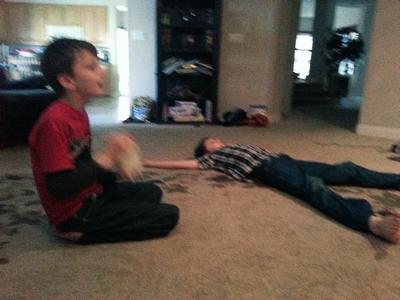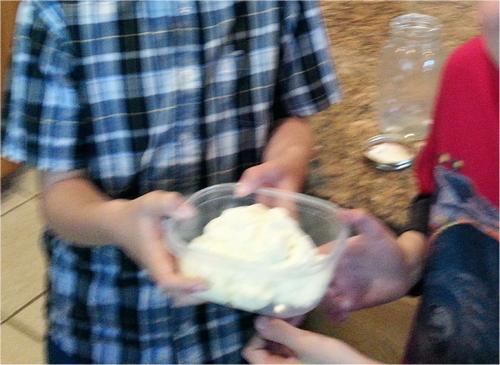In preparation, this weekend the kids and I decided to see what kind of life we could make for ourselves while the Four Horsemen duke it out with the Holy Ghost in what would arguably be the best D&D game ever.
It's not hunting season, so I can't take them out and show them how to get meat (I have already covered the science of grilling said meat, however) but in any future war-torn landscape we are sure to own chickens and at least have access to a cow. Eggs are pretty self-explanatory. Yes, they are chock full of scary-sound chemicals that would send Vani Hari shrieking if eggs had to have ingredient labels, but there is not much applied science to them.
Milk is another issue, though. Milk has all kinds of good chemistry lessons and terms like emulsion. And butter is basically a 15 minute chemistry lesson.
Don't bother with with talk about churning, at least the way we think of a butter churn, because it requires equipment and that makes people (including kids) think the equipment is the thing rather than the science. To make butter, all you need is a jar and a lid. And no one is really sure how and why churning works, in the same way we are unsure why aspirin works. We'll get to that in a bit.
Essentially, milk leads to skim milk and cream and then cream leads to buttermilk and butter. Two kinds of milk mean you basically get two kinds of pancakes. Even better.
Why does butter happen? The leading hypothesis is that as air gets into the cream (by shaking, in our case), bubbles form and tiny fat globules consisting of a phospholipid and lipoprotein membrane collect in them. If you continue to shake the cream, you go through the 'whipped cream' state, the membranes bust and emulsifiers like lecithin keep it from foaming again. As the foam settles, this liquid fat instead forms into a butter mass. At the chemistry level, emulsion created the cream and you are just undoing that.
I didn't want to sit around waiting for cream to separate so I just bought some heavy cream and let it get to room temperature to get the chemical process. Then the boys and I just sat around for 15 minutes shaking a jar.

They thought this was a lot of work. Welcome to life before
refrigeration. Credit: Hank Campbell
What about personalizing it? Like anything else with food, it takes some trial and error. The more whey you remove by continually washing and pulping the butter, the harder it will get, but the more you leave in, the more it will weep a little and it won't last as long if you like to leave it out on the counter.
Take a hint from the Amish and add salt. Yes, salt is correlated to lots of bad stuff, but so is butter, and no one can be sure it deserves that rap either. Plus, butter is not something you are eating in entire sticks so it is not going to give you a stroke. The lads liked the finished product.

Mason jar butter. Credit: Hank Campbell
Now to decide if I am on Team Michael or Team Gabriel after that fourth Blood Moon happens.
Resources:
http://www.webexhibits.org/butter/churning.html
http://drinc.ucdavis.edu/dfoods1_new.htm
The Houston Museum of Natural Science:



Comments